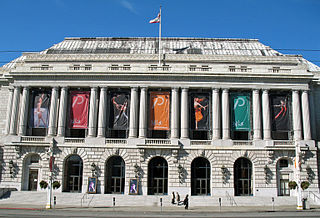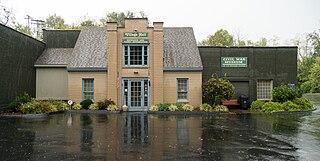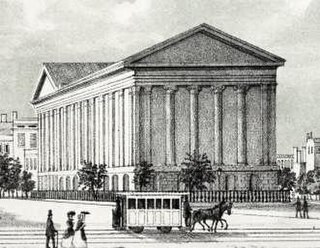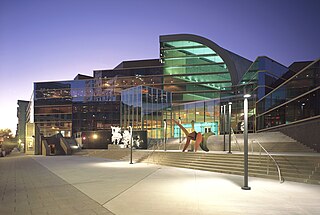Related Research Articles

The Auditorium Building in Chicago is one of the best-known designs of Louis Sullivan and Dankmar Adler. Completed in 1889, the building is located at the northwest corner of South Michigan Avenue and Ida B. Wells Drive. The building was designed to be a multi-use complex, including offices, a theater, and a hotel. As a young apprentice, Frank Lloyd Wright worked on some of the interior design.

Universal Amphitheatre was an indoor amphitheatre located in Los Angeles, California within Universal City. It was built as an outdoor venue, opening in the summer of 1972 with a production of Jesus Christ Superstar. It was remodeled and converted into an indoor theatre in 1982 to improve acoustics. The amphitheater closed on September 6, 2013 and was demolished for The Wizarding World of Harry Potter attraction at Universal Studios Hollywood.
The St. Louis Municipal Opera Theatre is an amphitheater located in St. Louis, Missouri. The theatre seats 11,000 people with about 1,500 free seats in the last nine rows that are available on a first come, first served basis.

The Woodstock Opera House is a historical venue for performing arts and receptions located in Woodstock, Illinois. It was built in 1889 and designed as a multi-use facility with space for city administration offices as well as police and fire departments. The building was planned by architect Smith Hoag and built by contractor Simon Brink for a cost of $25,000. Today, the City of Woodstock still owns the building, but the building is used exclusively as a performance space.

The War Memorial Opera House is an opera house in San Francisco, California, located on the western side of Van Ness Avenue across from the west side/rear facade of the San Francisco City Hall.

The Auditorium Theatre is a music and performance venue located in the Auditorium Building at 50 E. Ida B. Wells Drive in Chicago, Illinois. Inspired by the Richardsonian Romanesque Style of architect Henry Hobson Richardson, the building was designed by Dankmar Adler and Louis Sullivan and completed in 1889. The Chicago Symphony Orchestra performed in the theatre until 1904 as well as the Chicago Grand Opera Company and its successors the Chicago Opera Association and Chicago Civic Opera until its relocation to the Civic Opera House in 1929. The theater was home to the Joffrey Ballet from 1998 until 2020. It currently hosts a variety of concerts, musicals, performances, and events. Since the 1940s, it has been owned by Roosevelt University and since the 1960s it has been refurbished and managed by an independent non-profit arts organization.
The Ellie Caulkins Opera House is located in Denver, Colorado as part of the large Denver Performing Arts Complex. It seats 2,225. The Caulkins family pledged $7 million towards the enhancement of the lyric opera house and adjacent public spaces which were constructed inside of the Newton Auditorium.

The Tennessee Performing Arts Center (TPAC) is located in the James K. Polk Cultural Center at 505 Deaderick Street in downtown Nashville, Tennessee. It occupies a city block between 5th and 6th Avenues North and Deaderick and Union Streets. The cultural center adjoins the 18-story James K. Polk State Office Building.

The Grand Opera House is an opera house located at the corner of 8th and Iowa Streets in Dubuque, Iowa that was built in 1890. It was listed on the National Register of Historic Places in 2002.

The Civil War Museum in Bardstown, Kentucky, is a collection of five attractions along what is called "Museum Row". It was established in 1996 by Dr. Henry Spalding. The leading attraction is the Civil War Museum, which is the fourth largest American Civil War Museum and is dedicated to the Western Theater of the war. The main building was originally the icehouse and waterworks of Bardstown, and is 8,500 square feet (790 m2).

The performing arts community in Louisville, Kentucky is undergoing a renaissance. The Kentucky Center, dedicated in 1983, located in the downtown hotel and entertainment district, is a premiere performing arts center. It features a variety of plays and concerts, and is the performance home of the Louisville Ballet, Louisville Orchestra, Broadway Across America - Louisville, Music Theatre Louisville, Stage One, KentuckyShow! and the Kentucky Opera, which is the twelfth oldest opera in the United States. The center also manages the historic W. L. Lyons Brown Theatre, which opened in 1925 and is patterned after New York's acclaimed Music Box Theatre.

The Soldiers and Sailors Memorial Auditorium is a historic performance hall in Chattanooga, Tennessee. Built between 1922 and 1924 by John Parks at a cost of $700,000 and designed by noted architect R. H. Hunt, who also designed Chattanooga's lavish Tivoli Theatre, the theater honors area veterans of World War I.

The Riley Center, also known as the Grand Opera House and formally as the Mississippi State University Riley Center for Education and Performing Arts, is a performing arts and conference center in Meridian, Mississippi. It was added to the National Register of Historic Places in 1972.

The Jersey Opera House is a working theatre and opera house in La Vingtaine de la Ville, Saint Helier, Jersey, Channel Islands. The theatre building is administered by the States of Jersey but is managed by Jersey Opera House Limited. The current interim theatre director is Andy Eagle.

The Astor Opera House, also known as the Astor Place Opera House and later the Astor Place Theatre, was an opera house in Lower Manhattan, New York City, on Lafayette Street between Astor Place and East 8th Street. Designed by Isaiah Rogers (1800–1869), in the Classical Revival style of architecture, inspired by the temples of Ancient Greece and Rome of two thousand years earlier. The theater was conceived by impresario Edward Fry, the brother of composer William Henry Fry (1813–1864), who managed the famed opera house during its entire history.

The Palace Theatre is a music venue in downtown Louisville, Kentucky, located in the city's theater district, on the east side of Fourth Street, between Broadway and Chestnut Street. It has a seating capacity of 2,800 people and is owned by Live Nation. The historic landmark opened on September 1, 1928, and was designed by architect John Eberson. It was originally known as the Loew's and United Artists State theatre.

The Kentucky Center for the Performing Arts in Louisville, Kentucky, which opened in 1983, is owned by Kentucky Performing Arts and has tenants that include Kentucky Opera, Louisville Ballet, the Louisville Orchestra, StageOne Family Theatre and Broadway Across America. Sculptural artwork at the site is by Alexander Calder, Joan Miró, John Chamberlain, Jean Dubuffet and others.
Cal Performances is the performing arts presenting, commissioning and producing organization based at the University of California, Berkeley in Berkeley, California.
John Bailey McElfatrick (1828–1906) was an architect known for his design of theaters in the United States and Canada. He eventually went into practice with his sons William H. McElfatrick and John Morgan McElfatrick (1853-1891) in the firm J. B. McElfatrick & Sons.
References
38°13′33″N85°45′44″W / 38.22583°N 85.76222°W